June 13, 2025 | 17:17 GMT +7
June 13, 2025 | 17:17 GMT +7
Hotline: 0913.378.918
June 13, 2025 | 17:17 GMT +7
Hotline: 0913.378.918
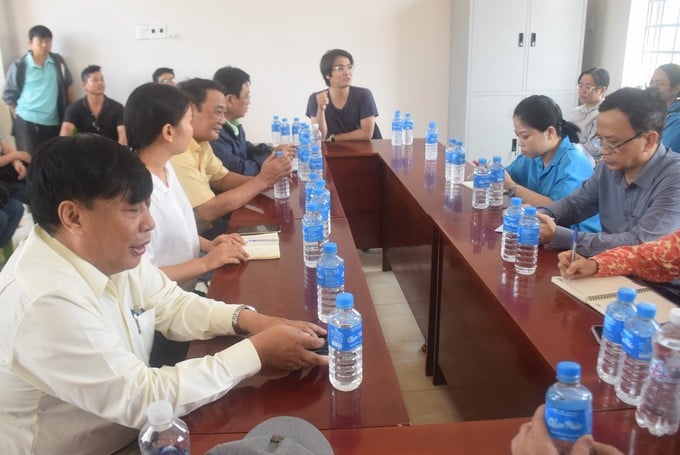
Mr. Tran Van Vinh, Deputy Director of Binh Dinh Sub-Department of Fisheries (far left), led a delegation of the Binh Dinh fisheries industry to find experts to study the seaweed farming profession. Photo: V.D.T.
Binh Dinh currently has approximately 1,200 fishing vessels with a length of 6m to below 15m, specializing in inshore and offshore fishing. In the process of restructuring the fisheries industry, Binh Dinh follows the direction of "reducing fishing, increasing farming" to both stabilize the livelihoods of people in coastal areas and reduce fishing pressure in the context of the decline in aquatic resources, especially near-shore aquatic resources.
In the coming period, Binh Dinh will calculate and gradually reduce the force of inshore fishing vessels. Accordingly, Binh Dinh will develop marine farming to stabilize the livelihoods of coastal people, especially the families of fishermen who have near-shore fishing vessels wishing to change professions.
According to Binh Dinh Department of Agriculture and Rural Development, the province has few advantages for developing marine farming because the sea in Binh Dinh is an open sea with many waves and wind. Therefore, at present, this locality has only more than 60 ha of saltwater aquaculture, concentrated in the near-shore waters in Quy Nhon city and Phu Cat and Phu My districts. Marine farming in Binh Dinh is mainly on a household scale, with traditional wooden cages. The farming objects are mainly lobster, barramundi, cobia, red snapper, grouper, broad squid, etc., with the participation of nearly 500 households living in coastal areas.
According to the plan, in the period of 2021–2030 with a vision to 2050, Binh Dinh will develop marine farming in the direction of high-tech application industries, diversifying farming objects and farming methods, ensuring biological safety and disease safety, and protecting the ecological environment. Seaweed is one of the objects selected by Binh Dinh to develop in the coming time.
Mr. Tran Van Vinh, Deputy Director of Binh Dinh Sub-Department of Fisheries, said that over the past few years, fishermen in the coastal areas of Binh Dinh had tried to grow seaweed but failed. Regarding the cause, the used seaweed variety did not attain good quality because it was mainly extracted from seaweed exploited in nature, already infected with diseases. Due to the lack of technical knowledge, the seaweed grown by farmers was frequently eaten by fish aor destroyed by the waves and wind, not to mention that the seawater was sweetened, causing it to be whitely decomposed and damaged.
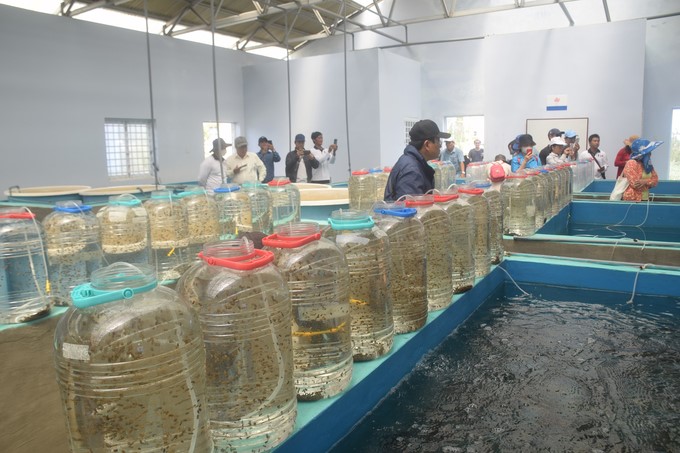
The delegation of the Binh Dinh fisheries industry visited the establishment of seaweed seed production by tissue culture method at DBLP Company in Tuy An district (Phu Yen). Photo: V.D.T.
But it remains true that Binh Dinh has many areas suitable for seaweed cultivation, especially in coastal communes of Nhon Hai, Nhon Ly, and Nhon Chau, and Ghenh Rang ward (Quy Nhon city). Nhon Hai commune currently has a sargassum forest under the seabed. From the beginning of April to the end of July every year, which is the breeding season of rockfish, the seaweed forest becomes a "maternity hospital" for the fish to come and breed. During that time, local people rushed to the sea to exploit the seaweed, which was then old. During the seaweed harvesting season, the people of Nhon Hai fishing village are always in a "full of money" status because the value of seaweed is quite high.
"Now, there is an available enterprise specializing in seaweed seed research and production by tissue culture method based in Phu Yen province, so it is not as passive as before. Tissue-cultured seedlings from the Philippines are carefully selected, disease-free, and have good resistance, so the planting will be effective. We are organizing a trial planting in Nhon Hai commune to perfect the process and evaluate the output. If successful, we will replicate it in Nhon Ly commune, Nhon Chau commune, and Ghenh Rang ward, and then in coastal localities like Phu Cat district, Phu My district, and Hoai Nhon town,” said Mr. Tran Van Vinh, Deputy Director of Binh Dinh Sub-Department of Fisheries.
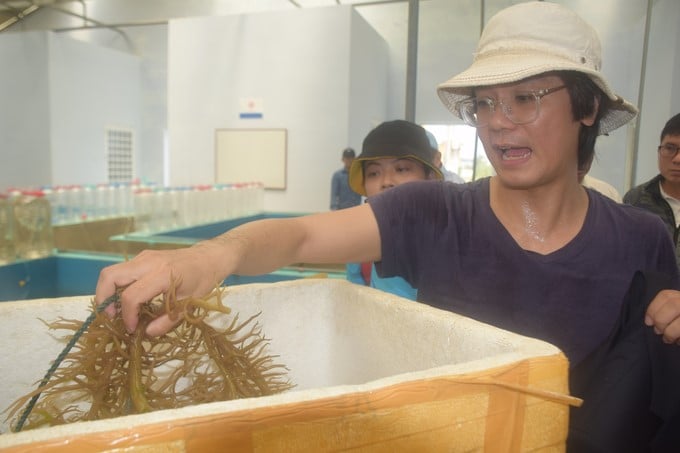
Mr. Do Linh Phuong, CEO of DBLP Company, instructs technicians of the Binh Dinh fisheries industry on how to grow seaweed. Photo: V.D.T.
The determination to pursuit the path of seaweed cultivation is presented in practical actions. The Binh Dinh delegation was led by Mr. Tran Van Vinh, Deputy Director of Binh Dinh Sub-Department of Fisheries, with the participation of 32 people, including officers from the Aquaculture Department of Binh Dinh Sub-Department of Fisheries, leaders of Binh Dinh Agricultural Extension Center, Quy Nhon City Economic Department, the community organization for protecting aquatic resources in coastal localities, and a large number of fishermen.
The delegation went on a field trip to the seaweed seed production establishment of DBLP Company, an enterprise which is located in Tuy An district (Phu Yen) and specializes in research and development of varieties, organization of raw material and processing areas, and supply of seaweed products for the market located in Tuy district. An (Phu Yen). Then the delegation went to the field of commercial seaweed farming in Song Cau town (Phu Yen) of Okinawa Co., Ltd.
At the seaweed seed production establishment of DBLP Company, the Binh Dinh delegation was clearly introduced by Mr. Do Linh Phuong, CEO and founder of DBLP Company, to the advantages and difficulties of seaweed development in Binh Dinh. According to Mr. Phuong, after his field trips to the sea area of Nhon Hai commune (Quy Nhon city), with a professional's eye, he assessed this as a potential sea area for seaweed farming. At the same time, Mr. Phuong also realized what needs to be overcome if he wishes to develop seaweed farming in Binh Dinh.
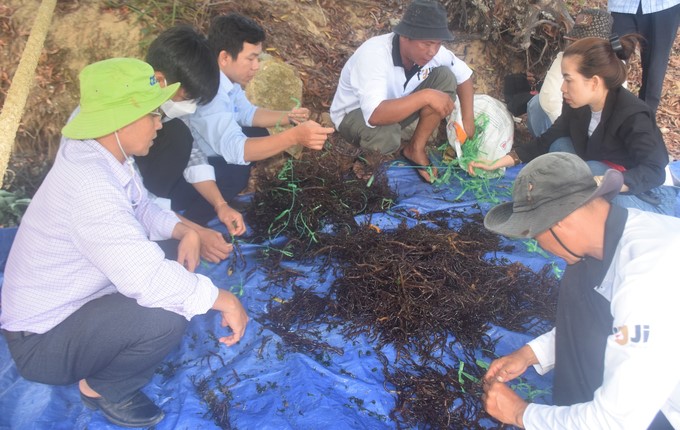
The technicians of the Binh Dinh fisheries industry learned how to tie seaweed seeds to the ropes for commercial farming from employees of Okinawa Co., Ltd. (Song Cau town, Phu Yen). Photo: V.D.T.
Mr. Do Linh Phuong shared that Binh Dinh currently has no saltwater or airtight area to nurture seaweed in the winter, like the waters located in an airtight bay in Phu Yen, so first, it is necessary to form regional linkages in seaweed farming development. Specifically, Phu Yen provides seeds, and Binh Dinh produces commercial seaweed. Second, Binh Dinh needs a force of professional and diligent seaweed growers because growing seaweed is a hard job. All day, seaweed growers have to soak themselves in saltwater to clean the hanging rope truss of seaweed, and all day they meticulously sit and tie the seaweed seeds to the ropes to bring out the farming truss in the sea.
"In areas where seaweed is grown on the shore, there must be a space to set up a camp so that when the seeds are transported from Phu Yen, the workers have a seat to tie the seeds to the ropes. This place must be close to the seaweed farming area and pump sea water into the area." Diligent people can tie 1,500–2,000 sprouts of seaweed seeds every day. The next necessity is funding. If Binh Dinh determines to grow seaweed in combination with tourism, it must grow seaweed in HPDE cages; the investment capital is thus quite high," said Mr. Phuong.
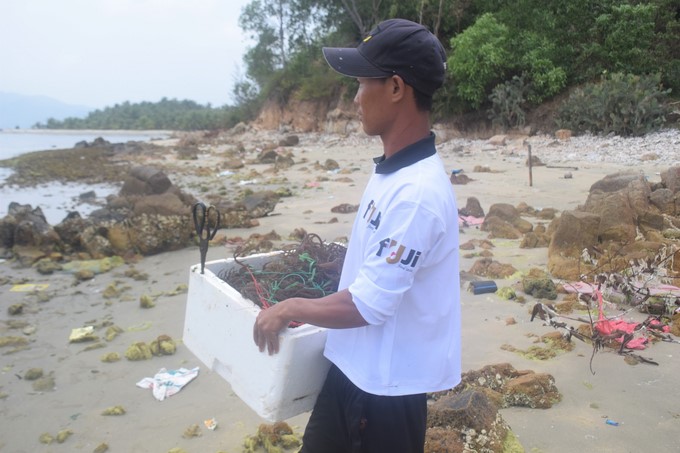
An employee of Okinawa Co., Ltd. (Song Cau town, Phu Yen) takes the ropes of seaweed to the sea and ties it to the truss for farming. Photo: V.D.T.
According to Mr. Phuong, the previous cultivation of seaweed was not effective because at that time, Vietnam did not have quality seaweed varieties. The varieties of seaweed grown by local people often sprout from seaweed grown from one crop to another; the variety is mainly exploited from nature, so it is often pre-incubated with pathogens, thereby the quality is not guaranteed. Now the country has produced tissue-cultured seaweed varieties, the origin of which has been selected, so the cultivation of seaweed is much more convenient. Particularly, DBLP's seaweed seed production establishment can produce 1-3 million seeds each year, enough to meet the needs of seaweed farming in the country.
"Every day our seaweed seed production establishment cuts about 20,000 sprouts for tissue culture. These sprouts are put into the laboratory to be processed for a few months before being released. Seaweed plants can't be cut at all locations. Technical staff only cut the sprouts that can be propagated. Embryo plants to cut sprouts for seeding should not be too old because they are easy to break. It is considered effective only when 1 ton of seaweed seed giving to the sea can give 30 tons of commercial seaweed," said Mr. Do Linh Phuong, CEO of DBLP Company.
Translated by Huyen Vu
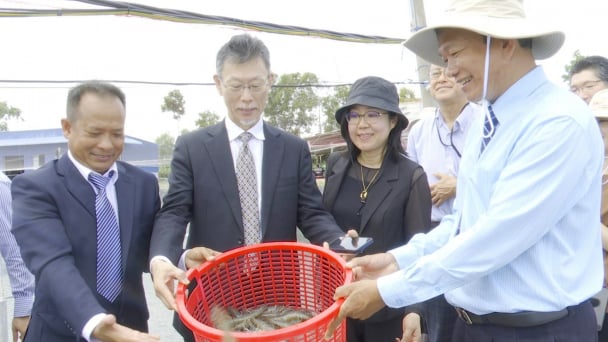
(VAN) In Tien Giang, a high-tech shrimp farm has developed a distinctive energy-saving farming model that has yielded promising results.
![Turning wind and rain into action: [3] 300.000 farmers benefit from agro-climatic bulletins](https://t.ex-cdn.com/nongnghiepmoitruong.vn/608w/files/news/2025/06/12/e5a48259d6a262fc3bb3-nongnghiep-125122.jpg)
(VAN) The agro-climatic bulletin has become a valuable tool for farmers in the Mekong Delta. After more than five years of implementation, the initiative is gradually being expanded nationwide.
![Turning wind and rain into action: [2] Providing forecasts to the people](https://t.ex-cdn.com/nongnghiepmoitruong.vn/608w/files/news/2025/06/12/e5a48259d6a262fc3bb3-nongnghiep-103927.jpg)
(VAN) In addition to improving the quality of hydrometeorological forecasts, putting forecast bulletins into practical use is crucial for production and disaster prevention.

(VAN) Blue carbon is receiving attention for its rapid absorption capacity and vast potential. It represents a promising nature-based solution to respond to climate change.
/2025/06/11/3507-1-161904_583.jpg)
(VAN) Seagrass beds and coral reefs serve as 'cradles' that nurture life in the ocean depths, creating rich aquatic resources in Vietnamese waters.
![Turning wind and rain into action: [1] Forecasting for farmers](https://t.ex-cdn.com/nongnghiepmoitruong.vn/608w/files/news/2025/06/11/e5a48259d6a262fc3bb3-nongnghiep-111919.jpg)
(VAN) Weather is no longer just a matter of fate. Forecasts have now become an essential companion for farmers in every crop season.
/2025/06/10/2501-3-082025_983.jpg)
(VAN) Mr. Le Hoang Minh, Head of Vinamilk's Net Zero project, recently shared insights on the integration of production, energy, and technology in Vinamilk’s green transition journey.